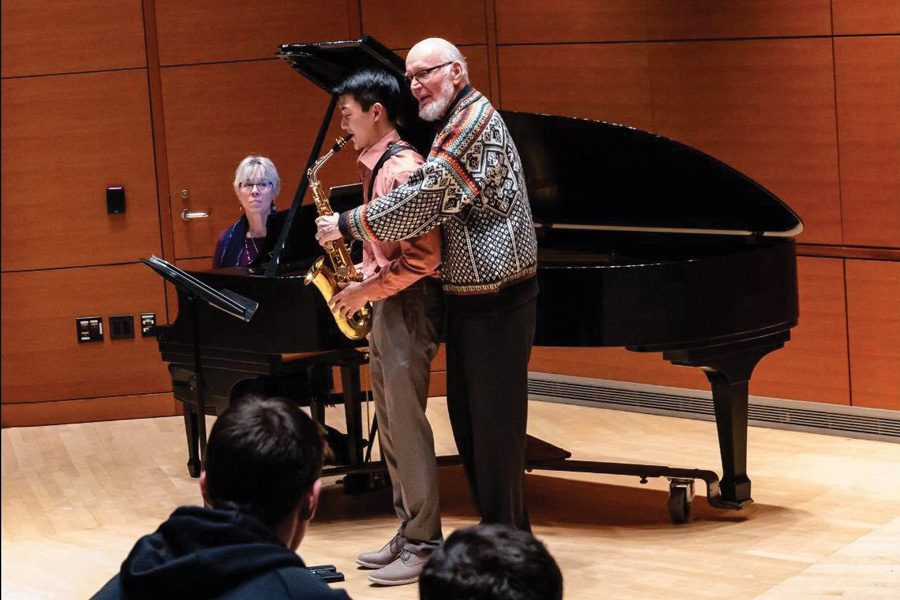Students, faculty share memories of a legend
Frederick Hemke works with Eric Zheng, during a 2018 masterclass. The saxophone professor taught generations of students during his decades at Northwestern.
May 16, 2019
Chris Forbes performed the Dahl Concerto for Frederick Hemke during a masterclass in 2017. At one point, as the professor offered critique and suggestions for improvement, Forbes remembers Hemke standing close behind him and wrapping his arms around to hold Forbes’ saxophone while Forbes blew into the horn — the infamous “Hemke Hug.”
“He did the Hemke Hug (to me) for the first time,” Forbes said. “It’s an iconic thing that you hear about for years and to have it done to you — it’s just a really funny thing to experience — this giant, 6’3’’ person wrapping his arms around you so that he can play your saxophone.”
Younger saxophone players tend to use an inconsistent airstream when blowing into the horn and pushing the keys at the same time, Forbes said, which isn’t ideal. Hemke used the technique to show students how to separate moving their fingers from blowing their air.
Forbes added that the Hemke Hug was famous in the saxophone world because Hemke was such an imposing figure — many smaller saxophone professors physically couldn’t reach around students the way Hemke could.
In the saxophone community, Hemke was a legend — the first American to ever receive the Premier Prix du Saxophone from the Conservatoire National de Musique in Paris. But students, friends, and faculty remember Frederick Hemke, who passed away in April, as larger than life — a towering man with an even bigger personality.
“He was kind of overpowering. I would see him around and I just remembered he was just a big presence,” said Sharon Rich Peterson, a Bienen staff accompanist who met Hemke as a Master’s student in 1979. “He was so tall, had a big voice, and was outgoing. You noticed him.”
Rich Peterson said she remembered the way that Hemke taught students in private lessons every week. His skill as a teacher, she said, really set him apart. He had a talent for picking apart even the most confident saxophone players, and working with them to close the gaps in their practice.
But Hemke’s greatest value as a teacher was not in his ability to teach the saxophone, Rich Peterson said. His teaching style was very “philosophical,” and Hemke cared more about teaching music and communication than how to simply play the instrument.
“Many teachers focus on playing the instrument well. Instead his focus was always on, ‘are you saying anything with your music?,’” Rich Peterson said. “‘Are you getting through to the people listening?’ That was what was important, not that you were a good saxophonist.”
Hemke’s skill as an educator extended beyond his techniques for helping younger students visualize proper technique, Forbes said. Hemke, born in 1935, had met and befriended composers that had written some of the saxophone’s most important repertoire.
When teaching, Forbes said, Hemke could recall the way those composers had wanted their music performed while they were still alive — making Hemke’s insight highly valuable to musicians who had come along after those composers had gone.
“It was kind of a crazy thing for me to hear about how there are people living who knew and worked with some of the composers who wrote our most notable saxophone repertoire,” Forbes said. “That was just like a really awe-inspiring moment for me.”
Without Hemke, Forbes said saxophonists “lose those connections to the past.” He added that what Hemke had done for saxophonists was so special it could never be replaced or replicated.
Hemke began teaching at Northwestern in 1962, and in that time he taught “generations” of saxophone players, Bienen saxophone Prof. Taimur Sullivan said.
“He just had an incredibly inspiring personality,” Sullivan said. He “would just inspire his students naturally to do better.”
Sullivan added that Hemke cared about teaching more than just the saxophone — he always ensured that his students were “growing as artists and intellectuals.”
Teachers and faculty who worked with Hemke remember him as a “Renaissance Man,” with interests in a wide range of topics outside music, such as visual art and learning northern European languages.
“He of course was a brilliant musician and saxophonist and pedagogue. But he also was a very visual artist,” Sullivan said. “He was a painter — his students have artworks of his.”
Rich Peterson remembers how Hemke taught himself Swedish and Norwegian from a children’s book so he could communicate with the students he taught each summer in Europe, and that Hemke had a cherished collection of handmade sweaters his Norwegian students had given to him in gratitude for his teaching.
Hemke’s relationships with his hundreds of students, grown over his decades of teaching, are what Rich Peterson remembers most.
“He loved to go over to the cafeteria to have lunch with the students. He also liked that that offered time to ask questions,” Rich Peterson said. “He loved to tell stories. He really liked the informal gathering times.”
Hemke took great joy in attending and playing at his students’ weddings, she added. He had played part of the Creston Sonata at one student’s wedding, and was “tickled pink” to attend another student’s service in Alice Millar Chapel.
Many of the students whose lives Hemke touched will travel back to the chapel June 2 to celebrate his life at a memorial service.
Sullivan said that while Hemke’s legacy to Northwestern is “irreplaceable,” the world is so much richer because of Hemke’s time at Northwestern.
“He was always asking them to look outside of just being saxophonists but growing as artists and intellectuals,” Sullivan said. “He really valued worldliness and creating the whole artist and the whole person beyond just being a good saxophonist. That was something he would always talk about.”
Email: [email protected]
Twitter: @theashowalter


